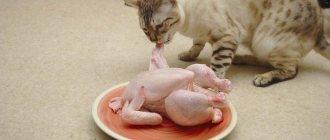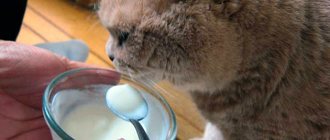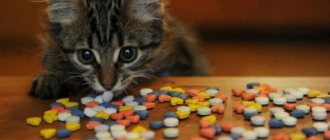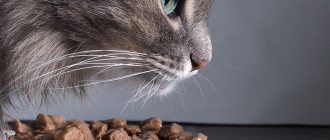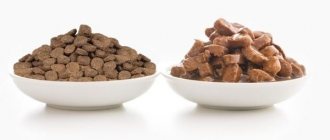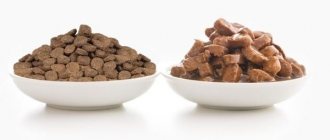Pet owners always try to pamper their pets, sometimes forgetting about the dangers of some products. It is known that cats love meat, some especially prefer pork. And they eat it in any form. In order for your pet to develop normally and grow healthy without causing trouble, you need to take a serious approach to choosing its diet. Particular attention should be paid to the choice of meat.
Why cats should not be given pork
This product was “rejected” completely undeservedly. There is no reason - someone somewhere heard that cats should not eat pork. Don't be surprised: those premium products that you buy for your pets with such trepidation contain a sufficient amount of pork and pork by-products. Those interested can check the portal - everything is eloquently described there.
Does this mean that pork meat can become the basis of your pet’s diet? Certainly not. Likewise, there are no contraindications to adding the product to the main diet.
We also caution you to add ham and other corned meat to your pet's food. No, not at all because of the fatty pork. Sodium is actively used in the preparation of ham and other meat delicacies. A slice of ham eaten by a cat automatically means that the cat’s daily needs for this chemical element are covered six times.
Trichinosis
Separately, it is worth mentioning trichinosis. This disease is considered one of the most dangerous. However, everything is complicated by the fact that the pathology is difficult to recognize. Often the diagnosis is made at a late stage, when the cat can no longer be helped or after its death.
The survivability of the larvae directly depends on the duration of infection. If they were encapsulated in meat or muscles, then they are not afraid of either boiling water or cold. As soon as the larvae enter the cat’s body, they will immediately burst and infection will begin. Trichylella live in the intestines for 45-60 days.
Then they move into the muscles, where they exist for years. This foreign invasion can cause cats :
- swelling;
- muscle pain;
- skin rashes;
- diarrhea;
- a sharp increase in temperature;
- changes and blood diseases.
Pork can be completely excluded from your cat’s diet. Otherwise, eating this type of meat can lead to kidney failure, liver cirrhosis, and pancreatitis. Pork can cause allergies and cardiovascular diseases. When purchasing offal, you need to look at the composition. Sometimes, in order not to indicate that it contains pork,...
Giving pork to cats, even boiled pork and even in small quantities, is also not recommended. Despite the fact that food in this form is well absorbed, there is still a risk of liver cirrhosis, pancreatitis, and chronic indigestion.
However, if the owners still decide to add pork to the cat’s food, then veterinarians advise buying only shoulder, heart or tenderloin, and completely free of fat.
The main dangers of pork
What dangers could your cat face when consuming this meat product? There are problems, and serious ones. Unfortunately, pigs themselves are susceptible to many dangerous diseases. In order to get sick, your pet only needs to eat raw meat from a sick animal.
Pork is quite a fatty product, this should also be kept in mind. Finally, many cats are diagnosed with individual intolerance to pork and experience allergic reactions.
Trichinosis
As for trichinosis, it is a very dangerous infectious disease. Infection mainly occurs through eating raw meat. In the last century, this was a real scourge for both farmers and veterinary services. Thank God, thanks to the effective system of measures adopted, the risk of purchasing contaminated meat is minimal. If you want to treat your pet to raw pork, purchase products intended for human consumption and only from trusted places. Never experiment with game - wild boar, elk, bear meat, etc.
Doctors say that trichinosis can be treated well with the same medications as roundworms. True, Trichinella larvae, which find refuge in muscle tissue, pose some danger.
Trichinella is spread by mice and rats. Be careful if your cat hunts rodents on the street, much less eats them. Then you will wonder for a long time where your pet contracted trichinosis.
Trichinella can be killed at home. Trichinella are afraid of heat treatment. Regular cooking of meat in a saucepan is not suitable. Suspicious meat must be cooked in the oven for at least an hour. At the same time, combine business with pleasure - you will have a wonderful roast. Don't forget to give your cat a piece.
High fat content
As for the high fat content in pork, there is no cause for alarm. Unless, of course, you give your cats raw pork meat and nothing else. And a piece of lean meat a day will only do you good.
In addition, in a pork carcass, in addition to areas that are truly saturated with fat, there are also so-called lean areas - carb, tenderloin, and shoulder. There is even less fat here than in chicken. Accordingly, with the right approach, pork can also become a dietary product.
Allergy
Cats either have a pork allergy or they don't. In the first case, do not take unnecessary risks, abstain from meat. The second point - do not put any food that is new to your cat in its bowl in excess. Introduce everything new gradually and see what comes of it. The first experiment was successful - you can continue to introduce new food further. Do not put too much stress on the animal's gastrointestinal tract.
Fish
Arguments why you can’t feed a cat fish are divided into three main types: about dangerous fish bones, then about infection with helminths, and the last one is metabolic disorders. On the one hand, everything is reasonable, but on the other hand, many cats literally pounce on fish and eat it with pleasure due to a lack of protein.
- Avoid freshwater fish - there is little benefit, and the risk of helminth infection is high.
- Ocean fish contains fatty amino acids, but it is not recommended to give it often - 1-2 times a week.
- Feed only thoroughly cleaned and cooked fish.
- Use fish as an additive to your main feed.
- It is not recommended to feed a cat fish after castration; a large amount of phosphorus can provoke the development of urolithiasis.
What kind of meat should I give - raw or cooked?
The product contains the most B vitamins compared to other types. It also contains a lot of zinc, magnesium, potassium, iron and other useful trace elements. All these substances are necessary for both cats and dogs so that their health does not deteriorate.
You can give your cat raw pork from time to time. This is how nature decided that all felines are predators. But in the wild or just on the street, no one prepares prey for them. The digestive system is designed to digest raw food.
The nuance is that there is a difference between a domestic cat and a wild or street cat. If a pet has eaten only store-bought food since birth, its gastrointestinal tract has developed in its own way and will have difficulty digesting the raw product and killing harmful bacteria.
Therefore, you should start from the situation. If your pet has always eaten raw meat, you can sometimes put it in a bowl. But for chronic diseases, especially in the esophagus, it is better to refuse such feeding.
Is it possible to give a cooked product?
After heat treatment, not only harmful but also beneficial substances are destroyed in any food. During cooking, up to 70% of thiamine and taurine are lost, and the protein is denatured. As a result, the digestion of boiled pork is complicated, because natural enzymes also disappear.
In general, there is no harm from the boiled product for a healthy pet. This product can be given from time to time. But one thing that is definitely forbidden is boiled bones. After heat treatment, they become insoluble and sharp, which can have dangerous consequences for the gastrointestinal tract.
Harm and benefit for cats
There is an opinion that this product is dangerous for pets. Pork should not be introduced into the diet of animals for several reasons:
- It is considered one of the fattest types of meat, and fatty foods are strictly prohibited for cats.
- Pork is difficult to digest and can disrupt the digestive system.
- Insufficient amount of protein and amino acids in the composition.
Sterilized and neutered cats should not be given pork. This is due to a sedentary lifestyle and the threat of obesity.
However, there are also positive qualities of pork meat. For example, the product contains a huge amount of B vitamins, which makes it possible to maintain the body’s energy balance. The meat also includes:
This product contains a lot of lysine, which is beneficial for the musculoskeletal system of the animal.
- Calcium and magnesium. Have a good effect on the cardiovascular system.
- Lysine. Correctly forms the joints and skeletal system.
- Iron. Enriches cells with oxygen.
- Zinc. Supports immunity.
Breed exceptions
What cereals can be given to dogs: is it possible to give porridge?
Can a Spitz eat pork? The answer to such a question will be negative. For small dogs such as Chihuahuas, Spitz, and Toy Terriers, fatty foods are contraindicated. In particular, due to the fact that these breeds are prone to obesity.
As for larger dogs, such as a shepherd, husky, or alabai, a small amount of pork in the diet will not cause harm. However, under no circumstances should you feed your animal raw meat.
Everything is good in moderation
What parts of pork carcass can be included in the diet?
The owner who decides to give his pet pork should know that the diet can include:
- ham meat;
- tails;
- snouts.
Pork heart for dogs is also an acceptable option. As for bones, they should be given out with great care. Ribs are not recommended for small breeds.
Another important question: is it possible to give lard or skin to a dog? In this case, there are no prohibitions, but it is best to limit yourself to the smallest amount. The skin is not a nutritious product, and lard is high in calories and has a minimal set of beneficial properties.
Can dogs have boiled pork?
For healthy animals, this type of boiled meat is not contraindicated. Especially if the meat component is pre-mixed with boiled potatoes or porridge. In this case, you will get a nutritious and healthy dish.
On the other hand, you should refrain from adding boiled meat to the diet or do it with extreme caution if your pet suffers from liver disease, spleen disease, tumors or hepatitis. It is worth noting that such ailments, in principle, require adherence to a strict diet, which does not include pork.
Mixed nutrition
There are three types of diet for domestic cats:
- natural nutrition from ordinary products familiar to humans;
- feeding with ready-made industrial feed created for animals;
- mixed diet, which involves feeding cats natural products in combination with ready-made food.
Natural food and raw meat
When feeding natural food, the issue with raw meat is resolved on its own. This product is included in the pet menu. It can be served in processed form. To get a more nutritious meal, veterinarians recommend combining meat pieces with other healthy foods.
Dry, wet food and raw meat
Is it necessary to feed a cat raw meat if it regularly eats ready-made industrial food?
Many experts do not recommend combining ready-made food with natural food, believing that such a composition will only cause harm to the animal’s body. Others recognize the possibility of mixed nutrition, but on the condition that an interval of several hours is maintained between feeding food and natural food. During this time, the cat’s body will have time to digest the previously consumed product.
If your cat eats premium wet food, it is not necessary to add raw meat to the menu. High-quality feed contains natural meat, so there is no need for additional complementary feeding with this product.
General Safety Tips
You can't tell if your pork is infested with Trichinella or pork tapeworms just by looking at it because these larvae are microscopic in size. Therefore, the best protection against trichinosis is thorough cooking of pork.
Trichinella die at a temperature of 58°C, and tapeworm eggs and larvae die at a temperature of 50–65°C (5, 8, 9).
One study found that pork tapeworm eggs and larvae can be killed at a lower temperature of 50°C in roasts that bake for 15 to 20 minutes, but higher temperatures of over 65°C are required when cooking ground pork dishes (8, 9).
Experts recommend cooking pork until its internal temperature reaches 63°C when cooking chops, steaks and pork tenderloin. Cook ground pork, processed meats, or mixtures until an internal temperature reaches at least 71°C (10°F) (10).
Whether it's pork or minced meat, you should let the meat rest for 3 minutes before eating it. This allows the meat to continue to cook and raise the temperature.
When cooked to 63°C, you may notice that white meat has a pink tint when you cut into it. According to revised USDA guidelines, this is acceptable.
To measure the temperature of your meat you must use a calibrated thermometer and follow the manufacturer's recommendations.
Proper food processing is also very important. This means that hand washing is a must when preparing food, as is using clean drinking water to wash surfaces, utensils or utensils.
Conclusion:
Cooking pork to a safe temperature is essential to avoid contamination. Although pork tenderloin, chops and steaks should be cooked to 63°C, ground pork should reach at least 71°C. Let the meat rest for 3 minutes before eating.
Bones
Yes, cats should not be given tubular chicken, sharp or boiled bones - this will really bring the animal to the operating table or death. However, by depriving your pet of bones, you doom him to calcium deficiency and toothache - cats clean their teeth by gnawing on solid food.
Cats can and should even be given:
- Chicken necks, openers, clean cartilage, pork ears, frozen and minced in a meat grinder until smooth.
- Special bones sold in pet stores. The composition may vary, but most often it is crushed bones, tendons, joints, and beef stomach.
- Large bones with remnants of meat that the cat cannot chew or fully take into its mouth.
- An alternative is good quality bone meal and brushing your teeth as needed.
British cats are classified as large breeds prone to obesity, if the animal is deprived of bones and cartilage on a natural diet, joints are guaranteed. When purchasing a Scottish fold cat, take into account the congenital gene mutation and slow restoration of bone tissue; the animal needs either high-quality industrial food or constant complementary feeding with calcium.
Important! When planning to purchase a fold-eared cat, be sure to read the veterinary passports and pedigrees of the parents. One of the parents must be straight-eared (straight), otherwise you risk acquiring a chronically ill pet.
